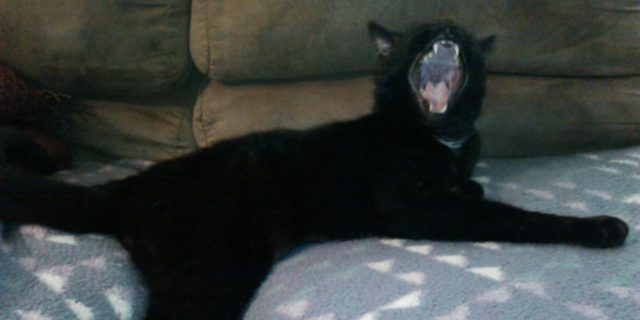“Cursed and Gifted with AS”
March 1, 2018—Yay! I do have a chronic, debilitating, painful, and incurable disease! My lifelong nightmare was over when I was diagnosed with Ankylosing Spondylitis and prescribed medication to help prevent, instead of just treat, my symptoms. This happened 37 years after my first symptom as a teenager, and almost 30 years after I began having chronic pain and other symptoms in parts of the body known to be affected by AS. Although some of my pain began after very minor injuries, I believe the chronic inflammation caused by AS was at the root of my health problems.
It’s genetic, man: My father and youngest brother, both named Rubin, had AS. My father’s symptoms began at age 18 with his first bout of uveitis. He soon developed unexplained knee and shoulder pain. In later years, he had GERD, a hip replacement, aortic valve disease, and colon cancer. His spine fused completely when he was in his 50s, and when he was 76, he fell and broke his neck in five places. He died at age 84 of a subdural hematoma.
“Little” Rubin’s battle with AS began with ulcerative colitis, which was initially misdiagnosed as irritable bowel syndrome (IBS). He also had chronic back and neck pain with very limited flexibility; he appeared to be fused like our father. Little Rubin eventually developed primary sclerosing cholangitis and bile duct cancer that I believe were complications of his AS-related colitis, and he passed away at age 50—just six months after our father died.
My story is similar to theirs, but like all AS patients, it’s different in its own way. The following is a timeline of my journey with AS:
Fall 1981—First shot fired: I was an active junior in high school when I began having unexplained fatigue. I could hardly get out of bed and had low energy during the day. My father, who besides having severe AS was an amputee with one leg, accused his able-bodied daughter of being lazy. I soon found that nicotine and caffeine helped me “manage” my fatigue, but after I gave them up many years later, my fatigue got progressively worse.
May 1989—Release the Kraken: I enlisted in the navy, and during boot camp I began having severe stomach pain and chronic constipation that was diagnosed as irritable bowel syndrome (IBS). After boot camp, I twisted my back slightly but developed persistent, severe pain that was diagnosed as chronic mid-back strain. Just two months after I injured my back, I hyperextended my knee and was diagnosed with chronic right knee strain. Why I had sudden, persistent pain was never investigated while I was in the service. I have dealt with chronic bowel, back, and knee pain ever since.
After having two major injuries in my first six months of active duty, I was placed on permanent light duty. Additionally, I was considered unfit for ship duty, so my seafaring dreams were crushed. At age 25, this was just the first of many disappointments caused by AS.
December 1992—Say hello to a new pain: One month after my son was born, I felt a sharp pain in my left hip that shot down to my knee. I was diagnosed with sciatica, which the doctor said was likely caused by the trauma of childbirth. Regular stretching helps, but I still get flares several times a year that hamper my mobility.
1998—Ah, my neck! I was rear-ended, and although the damage to my car was very minimal, I developed severe neck pain. I’d had no previous neck injuries, but I had herniated discs in three places. The natural curvature had straightened as well. The pain from that injury resolved, but I still have unexplained, extensive damage to my cervical spine and recurrent neck pain.
1999—Brace yourself: I started to get numbness, tingling, and pain in both wrists and hands that was diagnosed as carpal tunnel syndrome. Shortly after, I was diagnosed with GERD (GERD), and years later, with chronic gastritis. I reduced my digestive symptoms with medication and dietary changes, but they have persisted.
May 2000: Missed it by that much: After driving cross country, my back pain flared, and the x-ray showed “sclerosis” of my sacroiliac joint. I later learned that sclerosis (thickening or hardening of bone) is how sacroiliitis, an AS marker, can appear on an x-ray. The doctor didn’t mention this, but he tested me for the HLA-B27 gene. When it was negative, he diagnosed me with sacroiliac joint dysfunction. I received the same treatment that I’d gotten up until that point: physical therapy, NSAIDS, and painkillers.
January 2005—…and broke my sacroiliac: I bent to lift a bench when I suddenly felt such a sharp pain near my tailbone that I couldn’t stand back up. I was diagnosed with facet joint arthropathy and low back sprain, and received my first spinal injections. I was off work for five months, and at age 40 I began to realize that the biggest struggle of my life was going to be living in my own body.
2008-2010—Deterioration: My life became a pattern of manageable pain periodically interrupted by very painful flares. Now a single mother, I started working full time as an auto claims adjuster. Within months of driving hundreds of miles a week, my neck, back, and wrist pain flared up worse than they ever had. I was on disability for almost two years this time, during which my father and brother died. After their deaths, I became afraid I had AS, so I saw another doctor. This time, the x-ray of my sacroiliac joint was “unremarkable”, and I was still HLA-B27 negative, so he told me I didn’t have AS. He explained that my entire spine simply had degenerative disc disease.
2010-2017—Voodoo doll: During these years, I developed several new recurring symptoms: tenderness and pain in my chest and outer hips and thighs; pain in my thumb, heel, and elbow; shortness of breath; and excess protein and trace blood in my urine. I became depressed dealing with all this pain, and I’m sure my emotional state worsened my physical symptoms. I switched to a desk job, but sitting all day seemed to aggravate my symptoms even more.
In this 8-year period, I managed my pain with seven joint surgeries and numerous injections into ten different joints. I endured these procedures because I couldn’t take NSAIDS by mouth anymore. I also spent a small fortune on massages, heating pads, ice packs, braces, and seat cushions, and Biofreeze. I did get diagnosed with fibromyalgia in 2014, but the treatment for it had no effect on my joint and digestive symptoms.
Not surprisingly, working full-time became impossible, so I retired on disability in 2014. Fortunately, I managed to earn my master’s degree in 2010, and started teaching English as a Second Language to adults part-time after I retired. I love what I do, and it’s been a great diversion.
2018—Sick and tired of being sick and tired: After nearly 30 years of chronic pain and digestive issues, I’d gotten used to living with regular discomfort. However, I was growing weary of the flares, which were occurring more often and lasting longer (and now included debilitating fatigue and feverishness). Even the stiffness in my back in the morning, which used to be sporadic, had become a daily occurrence. It was like the first day of the flu every single day. When I could take it no longer, my only option was to go to the doctor for a Toradol (an NSAID) shot.
I was also an emotional wreck. Relieving stress was difficult. I had no energy for exercise, and leisure activities I’d previously enjoyed now increased my pain. I avoided social activities because of anticipated pain, but I was also tired of being housebound “socializing” through social media. Furthermore, I was angry that I although I was well-educated and experienced, my health had killed my career and stifled my earning potential. Worst of all, my disease had put a strain on my marriage and revealed how unsupportive some of my friends and family were. I was even called a hypochondriac. I became despondent, and occasionally suicidal.
Fortunately, when I reached the end of my rope, there was…Google. It started when I had a CT scan for an unrelated condition. The report said I had sacroiliitis and osteitis pubis—two diseases I’d never heard of, but had been suffering from for years. I googled their causes, and Ankylosing Spondylitis was all over the search results. I also discovered that my other recurrent conditions (costochondritis, trochanter bursitis, Achilles tendonitis, tennis and golfer’s elbow, De Quervain’s tenosynovitis) were possibly AS-related enthesitis.
I was convinced now that I had AS, but I remembered the HLA-B27 gene issue, so I did some research. I’m a black female, and I was surprised to learn that about half of African Americans with AS don’t have the gene. This wasn’t new information—it was discovered in the 1970s. Unfortunately, the doctors I’d seen up until then believed AS only happened to folks who were HLA-B27 positive, regardless of their symptoms.
Today— Acceptance and renewal: Armed with knowledge about AS and determined to have a thorough workup this time, I was fortunate to find a rheumatologist who really listened. He took my full history and ordered imaging studies of my entire spine, which showed active sacroiliitis and bone marrow edema (inflammation in the bone), two AS diagnostic criteria. He diagnosed me with AS when he got the test results and established a treatment plan. I was so relieved that I just sat in my car after the appointment and cried like a baby.
My first treatment was the biologic, Humira, which stopped working after several months. Now I’m on Enbrel, which helped give me my life back. I also manage my disease with regular stretching, exercise and massages, and I’ve found new leisure activities to relieve stress. Although I still live with daily pain and fatigue and occasional major flares, I’ve accepted my new life and no longer feel hopeless about my situation.
Lastly, I’ve also learned to forgive the people who haven’t been there for me and truly appreciate the angels who have. AS has been a curse and a gift in my life. It’s broken me physically over the years, but it’s also strengthened my resolve to live life to the fullest. Today, I’m the best I’ve ever been.





